27th: 9 Common Scoters at Calgary pier and at least 3 Turnstones at Lainne Sgeir, Calgary.
25th: 1 female Hen Harrier at Loch Carnain an Amais, Mishnish, 1 yellow-tagged White-tailed Eagle at Langamull flew over Mornish Schoolhouse and another flew west over Cillchriosd, 9 Common Scoters at Calgary pier.
24th: at least 2 Black-headed Gulls at Lagganulva.
23rd: 1 Purple Sandpiper, 4-5 Turnstones, 1 Redshank at Lainne Sgeir, Calgary; at least 8 (probably 9) Common Scoters near Calgary pier; at least 3 Long-tailed Tits at Calgary boathouse and 1 Red-throated Diver in the inner bay. 1 owl (probably Short-eared) at dusk on the Ensay side of Ensay Burn cattle-grid and a dead Short-eared Owl under the electric lines there.
A Drinker caterpillar where Ensay road hits the Calgary bay coast was my first November record.
22nd: About 40 Fieldfares at Treshnish wood and presumably the same flock around Ensay in the afternoon,3 Purple Sandpipers at Lainne Sgeir, Calgary (on rocky islets so impossible to get closer).
This Greylay Goose there seems to have a large amount of white at the base of the bill but I am sure the id is correct.
I think this is the same bird later at Calgary beach
Usual suspects: Heron
and Buzzard.
21st: Tawny Owl calling at night in Treshnish wood.
A fresh Hazel Gloves fungus was found about three trees to west of the rhododendron log pile.
At night it was unusual (this year only) to have moths coming to a window. One was a migrant, the Silver Y (my only November record) and the other Juniper Carpet ssp. scotica is a new species for Treshnish!
20th: 9 Common Scoters at Lainne Sgeir, Calgary and 2 or 3 Redwings nearer to the beach.
19th: Tawny Owl calling in Treshnish wood.
15th: 1 male Bullfinch calling at Treshnish Old Schoolhouse and 1 Black-headed Gull over Treshnish wood.
The Blackbird invasion continues with hundreds reported along the Dervaig-Salen road (Dave Sexton pers. comm.)
14th: I went to look for the Short-eared Owls but sheep gathering on the hill may have moved them on temporarily but whilst gathering, Jamie flushed 2 above Toechtamhor cottage, Haunn.
There were still plenty of Blackbirds around.This is one of a flock of at least 12 along with 2 Redwings by the cattlegrid at Ensay Burn. Although this is a female most of them are males.
For about the last fortnight Jamie has also been seeing hundreds of Blackbirds lining the roads, early morning between Dervaig at Achnacroig.
The Treshnish wood Buzzards are getting a bit less wary. The gradual narrowing of the tail bars shows this to be a juvenile
Usual suspect: Goldcrest.
13th: 2-5 Short-eared Owls after sunset, around Treshnish cow-barn and Black Park field (possibly only 2 circling back around me but I don't think so).
A small flock of 4+ Long-tailed Tits in Treshnish wood,
1 possible Jack Snipe at Treshnish boathouse and still more than normal numbers of Blackbirds around the farm. Woodcock in Black Park (will not be mentioned until spring unless high numbers occur).
12th: The 5 Common Scoters still between Calgary pier and the beach.
There were aboout 10 Redwings below Ensay farmhouse and further towards the Calgary coast, 6 Fieldfares and 1-2 Woodcocks. Tawny Owl calling in the evening in Treshnish wood.
Usual suspects: Buzzards.
One day I will catch this Buzzard defensive roll in focus
Don't look behind but...
11th: 5 Common Scoters off Calgary pier,
1 Turnstone and 1 possible Bar-tailed Godwit at Lainne Sgeir, Calgary, about 20 Redwings and later at least 12 Blackbirds below Ensay farmhouse.
Usual suspect: Shags.
An Otter on east side of Lainne Sgeir.
10th: I got back from a walk below Treshnish House where I saw a flock of at least 18 Blackbirds in the graveyard field and at least 12 in Black Park field, to see that a visitor from Ardnamurchan had seen c300 Blackbirds between Calgary and Ulva on the morning of the 8th (Alan Spellman in litt.). There were also at least 5 each of Redwing and Fieldfare around Treshnish wood and about 400 Starlings at the pre-roost gathering by Treshnish cow-barn. I don't think I have seen such a large flock there before.
This Sparrowhawk was hunting the Blackbirds (a second bird in the attack was either a Sparrowhawk or Kestrel).
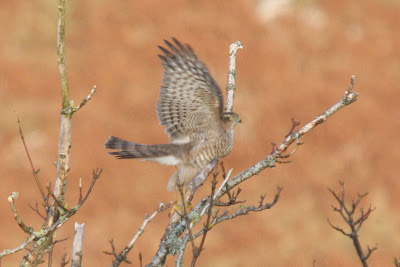
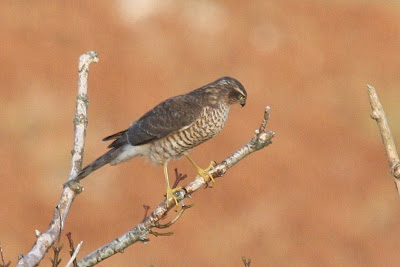

A Dipper is back at Ensay Burn mouth
where I saw my first Woodcock of the season. This was my earliest record at Treshnish (my previous earliest was on 18th November last year).
A snipe flushed at Treshnish boathouse may have been a Jack Snipe (it flew fairly straight and landed only 30m away, twice). In the evening a Tawny Owl was heard in Treshnish wood.
Usual suspect: Buzzard.
Moonrise over Ensay.
9th: 1 adult and 1 immature Gannet
and 4 Turnstones at Lainne Sgeir, Calgary where there was also another pale Rock Pipit.
I am pretty sure this is a 3rd winter Great Black-backed Gull. It could be confused with a Lesser but the legs would be yellow and the bill less thick.
Treshnish Point.
8th: At least 3 Fieldfares around Treshnish wood, at least 7 Redwings near Ensay and 5 Greenland White-fronted Geese flying south over Treshnish.
There was 1 Bar-tailed Godwit at Croig, presumably the same bird present on the 30th of October. A juvenile Cormorant was showing well with white belly but photos were poor.
Usual suspect: Heron.
and a Rock Pipit with prominent supercilium but not, I think, a Scandinavian Rock Pipit (which is thought by some authors to be almost impossible to identify in the autumn).
7th: About 50 Fieldfares and at least 10 Redwings around Ensay again being hassled by a Kestrel.
There were also about 40 Chaffinches at Ensay farmhouse.
6th: 5 Slavonian Grebes off Killiechronan
where there was a wing-tagged, black dot on yellow, White-tailed Eagle.
The first winter Iceland Gull was at Knock, fish-farm out-falls
where there were about 100 Black-headed Gulls (the Iceland Gull is in the centre with spread wings)
and by the bridge, 1 Dipper.
At Laggan the 2 Rooks were still present and there were about 200 Fieldfares and at least 2 Redwings.
Usual suspects at Knock: Teal
and Goldeneye
5th: A Great Spotted Woodpecker was heard in Treshnish wood. The Fieldfare influx continues with at least 2 near Calgary Farmhouse
and over 50 below Bennan farm.
Many divers passing south around Caliach Point. Several Great Northern, at least 5 Red-throated were identified and 2 possible Black-throated. 4 sightings of Black-headed Gull (all heading south around the point). 24 Whooper Swans flew from the north and landed at sea
and slowly slowly came towards Port na Caillich (the OS map has 2 different spelling for features in this area both different from 'Cailaich' the name of the farm on sign and phone-book). There were also 9 Wigeon here.
4th: There were at least 6 Fieldares at Ensay farmhouse along with 2 Redwings and a large flock of at least 50 flew south although they could have been Starlings. 2 Fieldfares were at the road summit.
Still looking for a good Fieldfare photo opportunity but they are proving very shy.
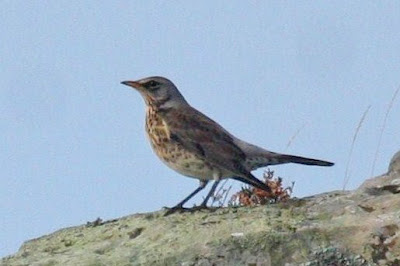
In the afternoon there was a loose flock of about 200 Fieldares
and Redwings at Ensay farmhouse (some were also in Treshnish wood)
which were attracting the attention of a Kestrel.

23 Greenland White-fronted Geese flew south over Treshnish wood.
There was 1 Purple Sandpiper at Lainne Sgeir, Calgary (my first of the season)


with the regular Ringed Plovers.
It was a good Buzzard day.
This one caught a vole or mole.

This shows the eyelid.
After breakfast naturally ...
Flock of 23 and 7 Whooper Swans and 3 Barnacle Geese flew south over Quinish (Mike Shepherd).
3rd: A pair of Golden Eagles between Burg and Tostary. This is the female.
Here I think it is trying to cough up a pellet.
There were at least 20 Fieldfares between Reudle Schoolhouse and Burg and at least 2 Redwings below Reudle Schoolhouse.
Usual suspect: Heron.
1 dog Otter on east side of Lainne Sgeir, Calgary and a smaller Otter about 300m towards Calgary.
2nd: About 12 Fieldfares near the Ensay Burg summit (Carolyne), 15 Redwings around Treshnish wood and 1 Gannet off Caliach Point.
1 Iceland Gull at Knock fish-farm outfalls (Mike Shepherd), where was it yestrday when i went to look!.
Whilst out with Andy Mortley at Croig last week he showed me a scent marking of an Otter. He has seen Otters making these secretions so there was no doubt what it was. If it is still there I will go back and get a photo meanwhile here is a photo of this anal jelly.
I have been doing a bit of research on Otter and Mink spraints. Years ago someone pointed out that the black oily droppings with a pointed end were from Otters. But last year I was told by a long term visitor that if there were no bones visible it wasn't an Otter's and often the ones described above have no bones showing so it appears that they are from Mink. The site above describes what to look for but states that Mink skats are smaller than 1cm diameter across and I am sure I have seen larger pointed droppings so now I need to keep an eye out and nose out because Otters spraint smell is not unpleasant.
Browsing similar sites allowed me to have a stab at some tracks I photographed on Ulva in 2009. At the time I presumed they were too small for Otter and therefore Mink. I didn't know until recently that there are Stoats on Mull and Ulva and I think that this is what these tracks are (the four toes on one side looks right).
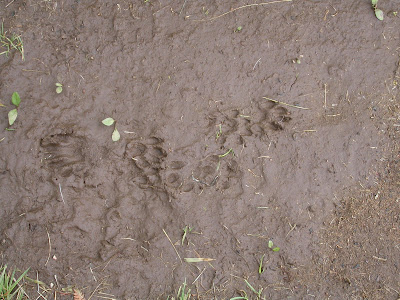
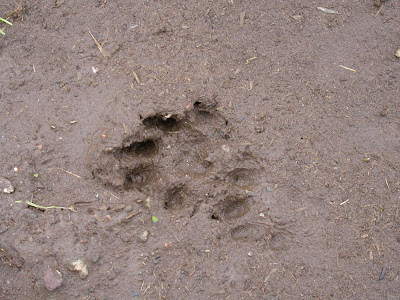
I did some research on the Hen Harrier which appeared to be hunting over the sea yesterday.
I came across this Note from British Birds
'Hen Harriers hunting over the sea
While counting gulls from the southern tip of the island [Copinsay] on the afternoon of 28th October, I noticed two female or immature Hen Harriers C. cyaneus circling over the sea some hundreds of metres to the southeast of the island. Numbers of Fieldfares Turdus pilaris and Redwings T. iliacus were flying low over the sea towards Copinsay and the adjacent part of Mainland and the harriers made repeated dives and low-level chases in pursuit of those which came close. After about 20 minutes, one of the harriers seemed to strike a thrush with either its wings or its talons; the victim dropped into the sea, only to rise again before the harrier was able to pick it up. The two harriers continued to chase thrushes repeatedly—but unsuccessfully—for a further 35 minutes and then flew back to Copinsay, where they spent the remainder of the day hunting in the conventional manner. Hunting over the sea by Hen Harriers seems likely to be even rarer than hunting over open water by Marsh Harriers. MARK BEAMAN'
I think this second Note fits the behaviour I saw yesterday better.
'Hen Harrier apparently attempting to catch fish
At 09.50 GMT on 26th December 1978, I watched a near-adult male Hen Harrier C. cyaneus passing along the eastern edge of a Pennine reservoir which is flanked by a narrow conifer belt and surrounded by open hill pasture..... On five occasions, while flying at a height of 1-2 m, it lost flight speed, almost hovered, and plunged feet-first quite slowly into the water, immersing its legs and thighs completely, with tail lying on water surface while keeping its wings clear of the water and beating steadily. It lifted cleanly out of the water after each immersion without any prey and eventually reached the south bank, where it landed. It subsequently flew out over the water three more times, but did not enter the water again. R. W. RHODES
Donald Watson has commented as follows: 'I have not myself seen Hen Harriers fishing or attempting to take fish, but the following observations are relevant:
...There are several old accounts of Hen Harriers taking dead fish, and migrating harriers, probably Pallid Harriers C. macrourus, have been observed pursuing and catching flying-fish over the Red Sea, which I quoted in my book The Hen Harrier (1977, pages 105 & 27).
'I cannot cite proof of Hen Harriers capturing live fish. Mr Rhodes's account certainly suggests an attempt to lift something from below the surface. I do not doubt that fish put back from keep-nets by anglers, such fish sometimes being dead, could be an attraction to a harrier; and one might even try for a live fish below the surface, as is suggested by Mr Rhodes's note.' EDS
1st: 1 Bar-tailed Godwit and 1 Whooper Swan at Killiechronan,
c80 Canada Geese , c50 Redwings and 4 Turnstones by Craignure Golfcourse, 40+ Black-headed Gull at Knock, 5+ at Killiechronan and at least 1 at Lagganulva.
2 Rooks near Ulva school.
About 8 Fieldares below Reudle Schoolhouse.
A ring-tailed Hen Harrier was hunting over the water and 1 juvenile Gannet both between Laggan and Ulva.
I found out today from Raymond Duncan more details of the colour-ringed Twite I saw at Treshnish Point on 20/09/2011. It was ringed on 30/01/11 at Foveran Links, Newburgh, 10 miles north of Aberdeen. This is now the 5th Mull bird.
On 16/05/2009 Tony Gibson photographed a ringed Twite at Haunn which was traced to one of 417 Twite ringed at Raggra, near Wick, Caithness between November and March 2000/2001. A colour ringed bird I found at Haunn on the 11/04/2010 was ringed at Melrose in the winter of 2008/2009 and another bird ringed in the same year at Melrose (same ring colours) was found by Alan Spellman on 12/05/2010 (a month after mine)at Loch na Keal. The 5th bird was ringed in NW England but I have no details except it looks as though it was found in between Treshnish and Loch na Keal. I am trying to find out more.
A paper on Twite rings and their movements is to be published soon in Scottish Birds.
1 Otter at Killiechronan. I think there is a cub on the left.
A Red Admiral flew at Craignure golfcourse or Salen bay (can't remember which).

